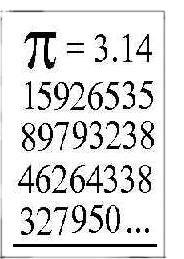|
|
|
|
Pi Symphony Overview
|
| |
Pi symphony was born in a Calculus I class in the early 1990's.
With my habit of making numbers into melodies, I decided to try the digits of pi. I was astonished to
discover the simple melody which does not sound at all random out to 32 digits.
At that time I did some more research and found that the digits of pi have only been
calculated out to several hundred digits for a couple of hundred years.
My goal then became to create a classic orchestration of this melody
which imparts the emotions associated with scientific discovery. Within a year or two,
I had finished the Pi Symphony, while studying Engineering/Physics at the University of Nebraska at Omaha.
I had several orchestral arrangements performed, but alas, never Pi.
I spent one entire summer editing and writing more on the score.
There are some .mp3 files of excerpts (below) from the synthesized rendition.
One goal of this site is to sell copies of my synthesized rendition, to hopefully
connect with an appropriate debut environment.
|
|
Pi Symphony Samples
|
| |
Please use samples as a reference. If you want to talk about Pi Symphony please purchase a copy. Don't just download the sample. SHeesh! Note all the COOL people below who have REAL copies of my work and will be forever included in the master score.
Pi and 'e'
Pi Symphony Movement #1 PI and e (7:00 minutes)
Real Audio Sample (32kbps)
40 sec. Mp3 sample 700k
This sample opens with pi rounded to 3.1416 on horn, followed
by the ensemble playing the same. Next a short fanfare digs
deeper into the digits. At 44: seconds, the flute plays pi
while all other instruments play snippets of the digital
sequence.
At 1:36, the melody of 'e' is introduced
on the flutes
At 1:45, The trupets play pi accompanied by
strings whose chordal structure is also dictated by the
digits.
The CIRCLE
Pi Symphony Movement #2 The CIRCLE (6:43 minutes)
Real Audio Sample (32kbps)
20 sec. Mp3 sample 400k
This sample opens with a fast run through the circle of
fourths followed by a semi-dissonant pi.
At 1:00 into the sample, we begin harmonically around the
circle of fourths.
At 2:03 you hear pi on the horns.
|
|
Contributors
|
| |
Contributors Include:
Michael Round Cedric Hartman Tina Nichols
Jim and Mary Jenkins
Frank Fauble
Scott Liberty
Peter Buffett
Rick Renn Jack Round
Anonymous ( $31.41 )
Ingrid Erickson
Daniel Wilkins
Judith Downey
John Konvalina
Jennifer Cook
Frank Stadler
Bahman Kalantari
C. Kelly Lohr
Wayne Hayes
Joel K. Haack
Ann McGill
Beth Novak
Patrick Michael McCarthy
(long lost friend rediscovered)
Stephen Griffith
Winston Baldwin
Reza Sarhangi
Louis Pachman
Dr. James J. Watters
Kim Yun Ju
Holly Herman
Lisa Gustafson
Paula Baddley
Chad P. Cotton
Margaret Herlihy
William Patrick
Jill Lombaer
James Eyrich
Maria Steffero
Mark Abbott
Kathleen E. McCarthy
Rodney J. Schmitz
Jean McQuillin
Christine Grablin
Debbie Pankow
Ken Hamik
Christ Van Willegen
Andy Gaines
Alan Friedman
Bruce Hendricks
Amy Cantrell
Mary L. Klar
Katherine F. Jankowski
Sandi Bruns
Jan Buckingham
David & Ginnie Tyler
John W. Threlkeld
Kathy Moore
Janice Gibson
Anita T. Ecker
Jennifer Lynn Rasel
Karen Collins
Mary Thornburg
Cindy Powell
Jonathon Robinson
Neal Grandgenett
Edward T. Pegg Jr.
Dave Frick-Wright
Roger A. Henrichson
Barb Mulliner
Louise McCoskey
Rita Bergeron
Ronald E. Keutzer, Marmion Academy
Patricia M. Iozzo
Diane Anderson
Kristin Bedell
Laura Bauer
Muriel L. Shaw
Scott Rodham
Kathy Layton
Maureen Rossi
Cathy Hundt, Archbishop Alter H.S.
Paul Alves
Lori Alexander
Doug Hanson
Mary Clausen
Lana Rhoads
David Lunbeck
Lawrence Bangay
Margaret Erickson
Daniel Schafer
|
|
|Home|
|Pi details|
|About Stone|
|The Inventions|
|More Hugh|
Music Store |
|
|

 Lars' Creative Warehouse
Lars' Creative Warehouse

 Lars' Creative Warehouse
Lars' Creative Warehouse